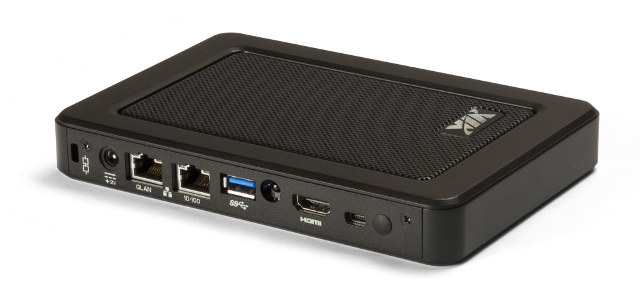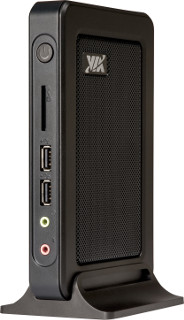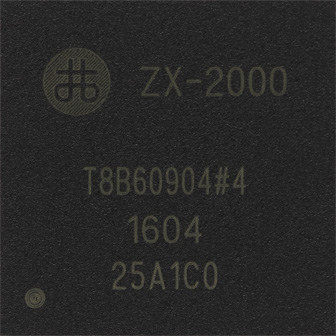VIA has just announced their latest ALTA DS 4K digital signage player with a “quad core Cortex A17 processor”, which I first assumed must be Rockchip RK3288 processor since it’s one of the few with that processor core. But the processor is actually from a company I had never heard before: Shanghai Zhaoxin Semiconductor that does both x86 and ARM SoCs for various markets.

But let’s check out the product with VIA ALTA DS 4K Digital Signage specifications:

- SoC – Zhaoxin ZX-2000M quad core ARM Cortex-A17 processor @ up to 1.4GHz with 2D/3G GPU supporting OpenGL ES 3.0, and a video processing unit
- System Memory – 2GB DDR3 @ 1600MHz
- Storage – 8GB eMMC Flash memory, SD card slot
- Video Output – HDMI 1.4 with CEC support
- Video Codecs – MPEG-2, VC-1, H.264 and H.265 video decoding up to 3840x2160p @30fps; H.264 encoding
- Connectivity – 1x Gigabit Ethernet port (Realtek RTL8211FS-CG), 1x 10/100M Ethernet port, optional 802.11 b/g/n Wi-Fi and Bluetooth 4.0 ( EMIO-5531 USB module)
- Audio – WM8960 Audio Codec; 2x 3.5mm audio jacks: Line-out and Mic-in
- USB – 2x USB 2.0 ports, 1x USB 3.0 port, 1x mini USB 2.0 port for COM (Tx/Rx)
- Misc – Power on/off button with power indicator LED, CIR receiver, antenna hole for Wi-Fi, Kensington lock, Wake-on-LAN, Watchdog timer
- Power Supply – 12V DC-in
- Dimensions – 175mm(W) x 25mm(H) x118mm(D)
- Weight – 500 grams
- Temperature Range – Operating: 0°C ~ 40°C; storage: -20°C ~ 70°C
- Operating Humidity – 0 ~ 90% @ 40°C (non-condensing)
- Compliance – BSMI, CE, FCC, NCC
The player runs Android 5.1.1, and can be placed vertically with a stand holder, or mounted behind a monitor via an optional VESA mount. Beside digital signage, the device is also expected for automated kiosks, check-out counters, and POS systems, and works with the company’s Android Signage Content Management apps. The dual Ethernet ports are designed to connect an IP camera while getting overlay data from the cloud.
 ZX-2000M processor seems to be part of ZX-2000 family with M and D parts. While I could not find the differences between the variants, the silicon vendor listed ZX-2000 specifications as follows:
ZX-2000M processor seems to be part of ZX-2000 family with M and D parts. While I could not find the differences between the variants, the silicon vendor listed ZX-2000 specifications as follows:
- CPU – Quad-core ARM Cortex-A17 CPU @ up to 1.6 GHz with 22000 DMIPS
- GPU – Zhaoxin independent intellectual property GPU with support for 1080p and 4K UI interface; 60 GFlops Smoothly
- VPU
- H.265 4K@60fps decoding; H.264 4Kx2K decoding; full format HD video decoding
- Lossless compression efficiency of video content is above 70%, saving an average of more than 50% memory bandwidth
- Tuner Support – Built-in two-way DVBC QAM demodulator, supporting a maximum TS stream output of 4-way
- Security / DRM – SARFT’s downloadable CA; ARM TrustZone; Secure Boot; DRM copyright protection; built-in OTG; Hardware based authentication mechanism preventing illegal software and flashing
- Process – TSMC’s 28 nm HPM technology
So the amount of information is rather limited, although the claim of a GPU designed in-house is intriguing.
ALTA DS 4K digital signage player can be ordered with or without a wireless module, as well as optional VESA mount, COM cable, and debug cable, but pricing is not publicly available. You may want to visit the product page for more information and documentation, such as the operating guide, and potentially inquire about the solution.

Jean-Luc started CNX Software in 2010 as a part-time endeavor, before quitting his job as a software engineering manager, and starting to write daily news, and reviews full time later in 2011.
Support CNX Software! Donate via cryptocurrencies, become a Patron on Patreon, or purchase goods on Amazon or Aliexpress




